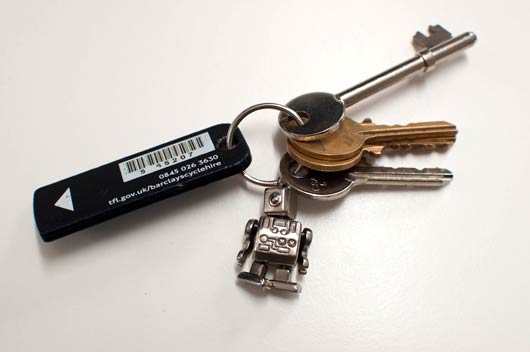
At one point during City Tracking, I commented that I still felt a connection to London during my time in San Francisco through the bike-key on my keyring (above).
(If you’re not aware of London’s cycle hire scheme – it’s a system of bike rental whereby bikes, distributed between docking stations around the city, can be unlocked with a plastic “key” and a small fee. It’s similar to Paris’ Vélib).
I suppose that could have mentioned my Oyster Card, but that usually lives tucked away in my wallet. The bike-key was something I touched several times everyday; it acts as a kind of key-fob for me.
I mentioned that, for me, the key acted as a kind of what Mike Kunivasky calls a Service Avatar. As Mike explains in his Microsoft Social Computing Summit talk:
“…because these things are now connected, their value moves from the device to the service it represents, and the actual objects become secondary. They become what I call service avatars.”
Mike is talking about electronic devices like digital cameras and TVs at this point in his talk – things that have functionality within them that is then connected to a service.
The bike-key has no functionality without the service: it’s just an RFID tag inside a piece of plastic. The service itself is unavoidably located in London. The computer systems that run it do not have to be, but the bikes themselves – the critical hardware within the service – cannot be located anywhere else.
The city and the service are tied together.
And so, for me, that keyfob that I pass through my fingers when I pick my keys up, or fidget with them in my pocket, is not just a service avatar; it’s an avatar for a city.
Then, of course, I have to unpack what I mean by “city”: not only the architecture and built environment, but also: the people within it; the transit systems that I experience so much of it through; the service layers including power, utilities, and even the payment schemes such as Oyster; the many digital layers on top, Foursquare and Gowalla and geotagged photos on Flickr and so forth.
The bike-key touches all of these: the built environment of the roads, the transit map, payment services, the digital infrastructure. It’s not just an avatar for a single service; in some ways, it’s an avatar for the entire “stack” of the city.
Time for a slight confession.
When I described the bike-key, I described it as a totem of London that I carried with me. When I said that, I wasn’t really referring to the traditional notion of an object describing the structure of kinship groups – although there are definitely comparisons to be drawn there, which Elizabeth Goodman touched on in her session on the final day.
My reference was more rooted in popular culture.

In Christopher Nolan’s recent film Inception, characters keep “totems” – small objects that behave in recognisably unique ways that only their owners know – to prove that they are truly in the real world to themselves (as opposed to being in one of the dream landscapes in which much of the film takes place).
All the totems seen in the film are objects with particular physical qualities – a spinning top, a loaded die, a poker chip, a weighted chesspiece – that behave in very particular ways (toppling, spinning) when subjected to the laws of real-world physics. Their totems prove that the laws of reality are in effect.
Nolan’s “totems” are reminders not just of the real world – but of the system that world runs on.
The bike-key in my pocket is a totem reminding me of larger systems – both the London bike network, and the city itself.
In San Francisco, it was a tangible reminder that London is still there, even though the key had no functionality in this particular city. Returned to London, the plastic key regains its powers, and returns to its normal behaviours: unlocking bicycles, capturing my usage of those bikes in its system.
As the city becomes increasingly networked – as Adam Greenfield describes eloquently in this post on the Urbanscale blog – there will inevitably be parts of that network, and thus parts of the city, that I can take with me.
On my keyring, everywhere I go, I carry a piece of London.